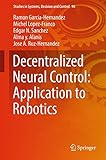Decentralized Neural Control: Application to Robotics [electronic resource] / by Ramon Garcia-Hernandez, Michel Lopez-Franco, Edgar N. Sanchez, Alma y. Alanis, Jose A. Ruz-Hernandez.
By: Garcia-Hernandez, Ramon [author.] .
.
Contributor(s): Lopez-Franco, Michel [author.] | Sanchez, Edgar N [author.]
| Sanchez, Edgar N [author.] | Alanis, Alma y [author.]
| Alanis, Alma y [author.] | Ruz-Hernandez, Jose A [author.]
| Ruz-Hernandez, Jose A [author.] | SpringerLink (Online service)
| SpringerLink (Online service) .
.
Material type:  BookSeries: Studies in Systems, Decision and Control: 96Publisher: Cham : Springer International Publishing : Imprint: Springer, 2017Edition: 1st ed. 2017.Description: XV, 111 p. 54 illus., 3 illus. in color. online resource.Content type: text Media type: computer Carrier type: online resourceISBN: 9783319533124.Subject(s): Computational intelligence
BookSeries: Studies in Systems, Decision and Control: 96Publisher: Cham : Springer International Publishing : Imprint: Springer, 2017Edition: 1st ed. 2017.Description: XV, 111 p. 54 illus., 3 illus. in color. online resource.Content type: text Media type: computer Carrier type: online resourceISBN: 9783319533124.Subject(s): Computational intelligenceIntroduction -- Foundations -- Decentralized Neural Block Control -- Decentralized Neural Backstepping Control -- Decentralized Inverse Optimal Control for Stabilization: a CLF Approach -- Decentralized Inverse Optimal Control for Trajectory Tracking -- Robotics Application -- Conclusions.
This book provides a decentralized approach for the identification and control of robotics systems. It also presents recent research in decentralized neural control and includes applications to robotics. Decentralized control is free from difficulties due to complexity in design, debugging, data gathering and storage requirements, making it preferable for interconnected systems. Furthermore, as opposed to the centralized approach, it can be implemented with parallel processors. This approach deals with four decentralized control schemes, which are able to identify the robot dynamics. The training of each neural network is performed on-line using an extended Kalman filter (EKF). The first indirect decentralized control scheme applies the discrete-time block control approach, to formulate a nonlinear sliding manifold. The second direct decentralized neural control scheme is based on the backstepping technique, approximated by a high order neural network. The third control scheme applies a decentralized neural inverse optimal control for stabilization. The fourth decentralized neural inverse optimal control is designed for trajectory tracking. This comprehensive work on decentralized control of robot manipulators and mobile robots is intended for professors, students and professionals wanting to understand and apply advanced knowledge in their field of work. .


There are no comments for this item.